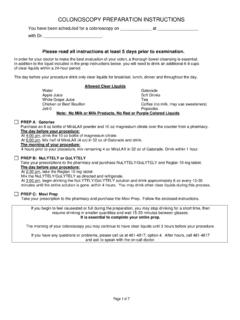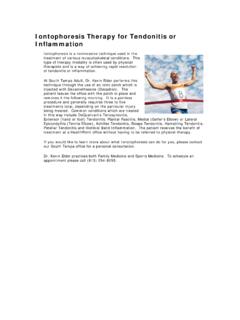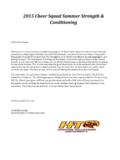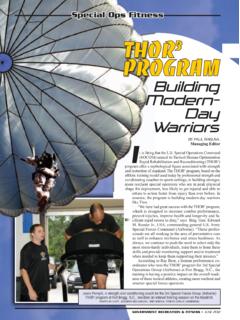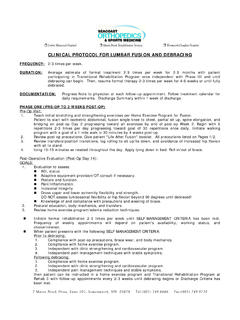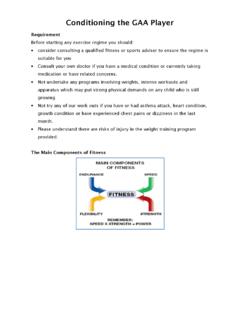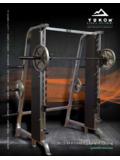Transcription of MENISCAL REPAIR PROTOCOL - Medfusion
1 Bruce A. Stewart, MD, MBA Orthopaedic Surgeon/Sports Medicine Specialist 370 N. 120th Avenue Holland MI 49424 P MENISCAL REPAIR PROTOCOL The fibro cartilaginous menisci act as shock absorbers, force distributors, and aid in knee stabilization. Menis-cal tears are the most common of all knee injuries. The most common mechanism of injury is twisting the knee with a planted foot. A pop is often audible followed by severe pain and swelling. With the next few days, the patient may notice a catching feeling or feel that the knee is locked up and gives way. Stairs may be difficulty and painful as well as squatting and kneeling activities. If conservative treatment fails and the tear is in a location in which healing can occur, a MENISCAL REPAIR is indicated. If at all possible, it is beneficial to REPAIR a tear rather than remove part of the meniscus because 70-90% of people who undergo total menisectomies have osteoarthritis OA in the knee joint within 10 years.
2 The greater the amount of meniscus that can be saved, the more stability and the less chance of ar-thritis down the road. Following surgery, it is important to consult with Dr. Stewart regarding the size of the tear and subsequent REPAIR . This will affect the time frame for limiting ROM and weight bear-ing. If the REPAIR was made at the outer third or periphery of the meniscus, where ample blood supply exists, faster healing can be expected and rehab should progress accordingly. The following PROTOCOL should be followed unless otherwise instructed following a MENISCAL REPAIR . Rehab for the first 6 weeks following a REPAIR is critical but boring. Limited exercises can be done due to the ROM and WB ing precautions. These exercises are critical however. It is important to allow the REPAIR to heal and to avoid stress to the meniscus during this time frame.
3 Squatting or kneeling is contra-indicated. *The hamstrings attach to the posterior portion of the meniscus and therefore, active and resistive hamstring activity should be avoided for at least 6 weeks post-op! *A home exercise program is critical and should be emphasized heavily to the patient, especially initially. The more the patient does at home, the faster recovery will be. PHASE ONE: Weeks 1-3 Following surgery, the patient will be placed in an immobilizer which will be worn for at least 3 weeks. Dr. Stewart s belief is that for small repairs, the patient can partially weight bear in with the brace in exten-sion after surgery, but that for larger tears no weight bearing should be done in either flexion or extension for the first 4 weeks, and only partial weight bearing in extension for weeks 4-6. PROM and AAROM 0-30 for the first week, 0-60 for the second week, and 0-90 for the third week.
4 EXERCISES/STRENGTH/NM CONTROL Quad sets with EMS or bio feedback - the more the better; 100x/day SLR - 4 way SAQ LAQ Seated hip flexion Multi-hip RANGE OF MOTION: Heel slides - follow precautions!!!! Hamstring and calf stretch - hold 30 seconds Prone hangs to gain full knee extension MODALITIES: EMS or EGS if needed for quad facilitation or swelling, respectively Ice following exercise and initially, every hour for 20 minutes *The hamstrings attach to the posterior portion of the meniscus and therefore, active and resistive hamstring activity should be avoided for at least 6 weeks post-op! PT should perform HEP 3x/day Bruce A. Stewart, MD, MBA Orthopaedic Surgeon/Sports Medicine Specialist 370 N. 120th Avenue Holland MI 49424 P MENISCAL REPAIR PROTOCOL PHASE TWO: Weeks 3-6 ROM can now be progressed slowly, as tolerated Deep flexion in a weight bearing position should NOT be performed Limit closed chain exercises to 90 For small tears, the patient can discontinue immobilization and work towards a normal gait pattern.
5 Crutches can be discharged when a normal gait is achieved. For large tears, the patient may begin partial weight bearing with the knee immobilizer locked in exten-sion after 4 weeks. EXERCISES/STRENGTH Quad sets are continued until swelling is gone and quad tone is good SLR (4 way) add ankle weights when ready Weight shifting - lateral; forward/backward Shuttle/Total gym - (limit to 90 ) bilateral and unilateral - focus on weight distribution more on heel than toes to avoid overload on Patella tendon Multi-hip - increase intensity as able Leg Press (limit to 90 ) Step-ups - forward Wall slides (limit to 90 ) Mini-squats - focus on even distribution of weight Calf raises RANGE OF MOTION Goal is 0-125 Patella mobilization - manual - especially superior and inferior Perform scar massage aggressively at portals and incision Heel slides - seated and/or supine at wall Continue with HS and calf stretching Bicycle - do not perform until 110 of flexion are achieved - do NOT use bike to gain ROM.
6 Perform daily and increase resistance as able to work quad. BALANCE Single leg stance - even and uneven surface - focus on knee flexion Plyoball - toss Lateral cone walking with single leg balance between each cone GAIT Cone walking - forward and lateral D/C crutches when normal gait MODALITIES Continue to use ice following exercise Continue with HEP daily By end of this phase, the patient should ambulate with normal gait I, have good quad control, controlled swelling, and be able to ascend/descend stairs PHASE THREE: Weeks 6-12 For large tears, the patient can discontinue immobilization and work towards a normal gait pattern. Crutches can be discharged when a normal gait is achieved. Goals for this phase are full quad control, good quad tone, and full ROM; patient should be able to per-form normal ADLs without difficulty. Exercises will be advanced in intensity based on quad tone - a patient who continues to have poor quad tone must not be advanced to activities that require high quad strength such as squats and lunges.
7 Bruce A. Stewart, MD, MBA Orthopaedic Surgeon/Sports Medicine Specialist 370 N. 120th Avenue Holland MI 49424 P MENISCAL REPAIR PROTOCOL PHASE THREE: Weeks 6-12 (cont d) STRENGTH Continue with previous exercises, increasing intensity as able Step-ups - forward and lateral; add dumbbells to increase I; focus on slow and controlled movement during the ascent and descent. Squats - Smith press or standing Lunges forward and reverse; add dumbbells or medicine ball Hamstring curls (not until week 7) Single leg squats Russian dead lifts bilateral and unilateral Single leg wall squats Cycle - increase intensity; single leg cycle maintaining 80 RPM RANGE OF MOTION Full ROM should be achieved Continue with hamstring and calf stretch Initiate quad stretch BALANCE Plyoball - toss - even and uneven surface Strength activities such as step-ups and lunges on airex MODALITIES Continue to use ice after exercise Continue with HEP at least 3x/week PHASE FOUR: Weeks 12-36 Continue with previous strengthening program 3x/week, focusing on increasing intensity and decreasing reps (6-10) for increased strength.
8 Initiate lateral movements and sports cord: lunges - forward, backward, or side step with sports cord, lat step-ups with sports cord, step over hurdles. Jogging Plyometric program - bilateral progressing to unilateral (plyos can include squat jumps, tuck jumps, box jumps, depth jumps, 180 jumps, cone jumps, broad jumps, scissor hops) Leg circuit: squats, lunges, scissor jumps on step, squat jumps Power skipping Bounding in place and for distance Quick feet on step - forward and side-to-side - use sports cord Progress lateral movements - shuffles with sports cord; slide board Ladder drills Swimming - all styles Focus should be on quality, NOT quantity Landing from jumps is critical knees should flex to 30 and should be aligned over second toe. Control-ling valgus will be initially be a challenge and unilateral hops should not be performed until this is achieved.
9 Initiate sprints and cutting drills. Progression: straight line, figure 8, circles, 45 turns, 90 cuts. Carioca Sports specific drills Single leg hop test Bruce A. Stewart, MD, MBA Orthopaedic Surgeon/Sports Medicine Specialist 370 N. 120th Avenue Holland MI 49424 P MENISCAL REPAIR PROTOCOL PHASE FOUR: Weeks 12-36 (cont d) Biodex test Biodex Goals: Peak Torque/BW Males Peak Torque/BS Females 60 /s (%) 110-115 80-95 180 /s (%) 60-75 50-65 300 /s (%) 30-40 30-45
